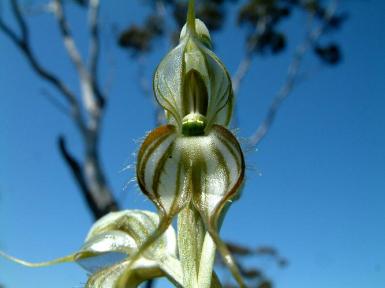Could the rather prosaically named two-bristle greenhood (Pterostylis psammophila) be one of the world’s rarest orchids?
If so (and there are only around 90 left out there in the Barossa Valley) then the federal government appears to be hedging its bets about possibly listing this South Australian rarity as critically endangered.
The small green and white orchid is the latest species in a list of consultation listing assessments being churned out with little fan fanfare by the federal Department of Environment in what appears to be a box-ticking (or in-tray clearing) exercise.
The assessment document published on the department’s website warns that so little is known about the orchid that it will be difficult to demonstrate its eligibility for critically endangered status. So, don’t get your hopes up……
Perhaps it should be called the Catch 22 orchid. Yep, it’s rare but where’s the data to prove it? Koala ecologists know this catch all too well……if you can’t count ’em, then the government can claim it doesn’t have reliable estimates to make a decision.
But botanists do know that the greenhood has suffered an 80 per cent population decline over the past five years. Why? Same old culprits……land clearing, rabbits, weeds, loss of pollinators, drought (aka climate chang)……and sand mining. There seems to be some illegal collecting occurring as well.
It’s not flashy enough to be considered a ministerial photo opp species……..yet it could be, for a minister who’s a native plant enthusiast…..
“Flowers are green or translucent white when flowering starts,” says the listing document.
“Flower stem are short and stocky, usually less than 15 cm high but elongating in late flower, with several leafy bracts ….Occurs in deep white sands in open woodland.”
According to SA government surveys, the orchid is now only known from two locations in the Barossa Valley, north of Adelaide.
“The total number of flowering plants recorded during the last survey was only 20 individuals,” says a SA government report published earlier this year.
“The highest number of flowering plants recorded since surveys began was 94 individuals in 2008…. The actual number of mature individuals (including flowering and non-flowering plants) is possibly greater than 100, but is unlikely to be more than 250.”
In 2011, botanist Robert Bates from the SA Herbarium described the greenhood as previously occurring “in very large scattered colonies of thousands of plants in ideal habitat.”
Bates has also suggested the species could have a wider distribution across Eyre Peninsula and Yorke Peninsula in SA, and in areas of New South Wales.
“There are no records to confirm this,” says the federal listing document.
“There has been no research into the biology or ecology of this species.”
Senate inquiries are being a bit overdone at the moment, but Australia does need a serious national inquiry into the declining status (and funding) of botany in our universities and government science agencies.
There’s seems to be government funding to turn botanical gardens into wedding venues and tourist theme parks, but not for the science that should drive these places.
But, getting back to the two-bristle greenhood, the Department of Environment is calling for public comment on its listing document. The deadline is 5 October, so pile on the submissions.
And a word about the photo…….that’s not P.psammophila but a close SA relative, just to give some idea of what we’re likely to lose if the government doesn’t come up with a critically endangered listing, a recovery plan for the greenhood and a pot of money to fund field surveys and science.


Isn’t this always the way? If the thing in need of help isn’t deemed “sexy” enough no one wants to do anything about it. Is it legal to propagate this species for reintroduction? Sometimes one must take matters into their own hands. Perhaps some midnight plantings can help their numbers.
LikeLike